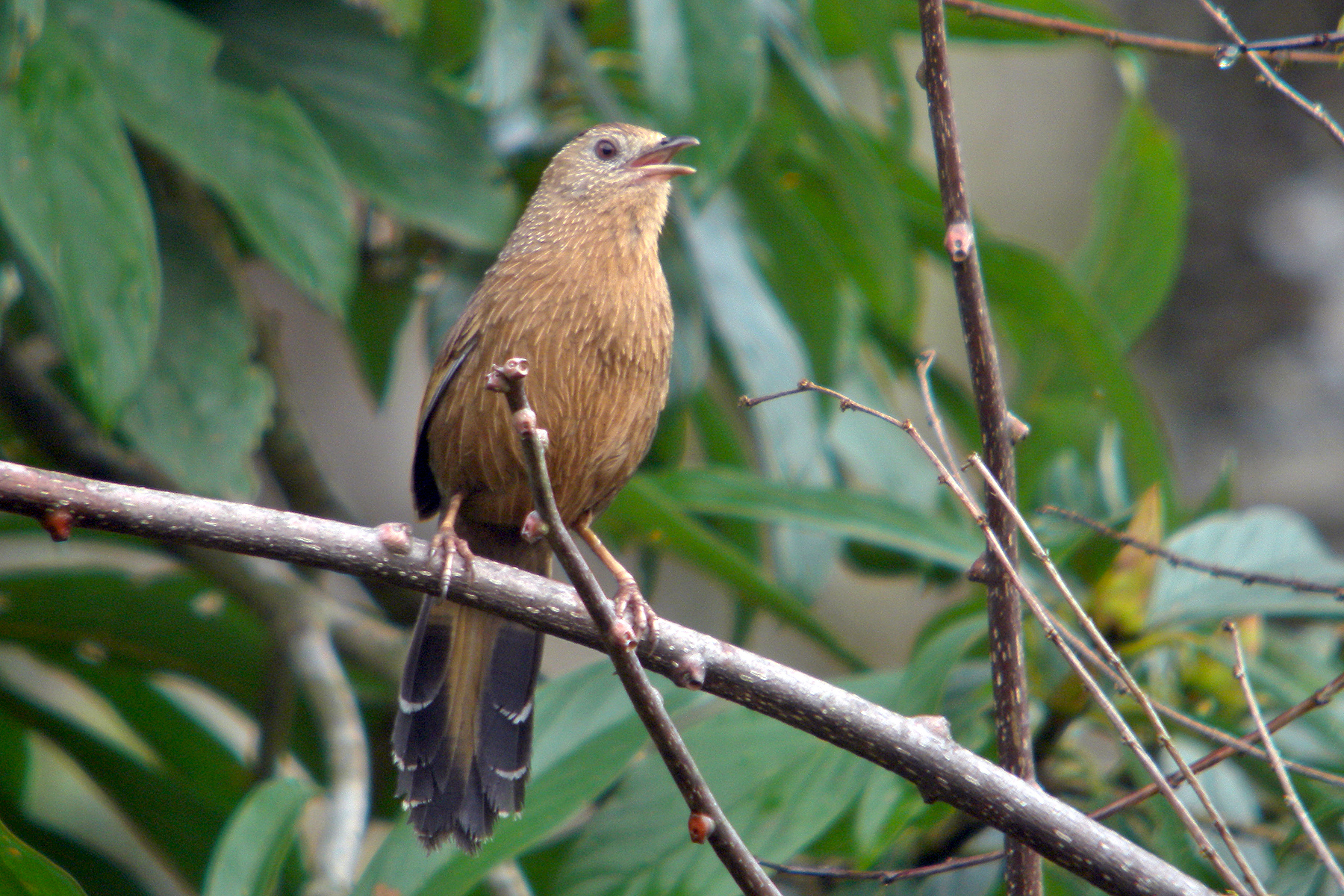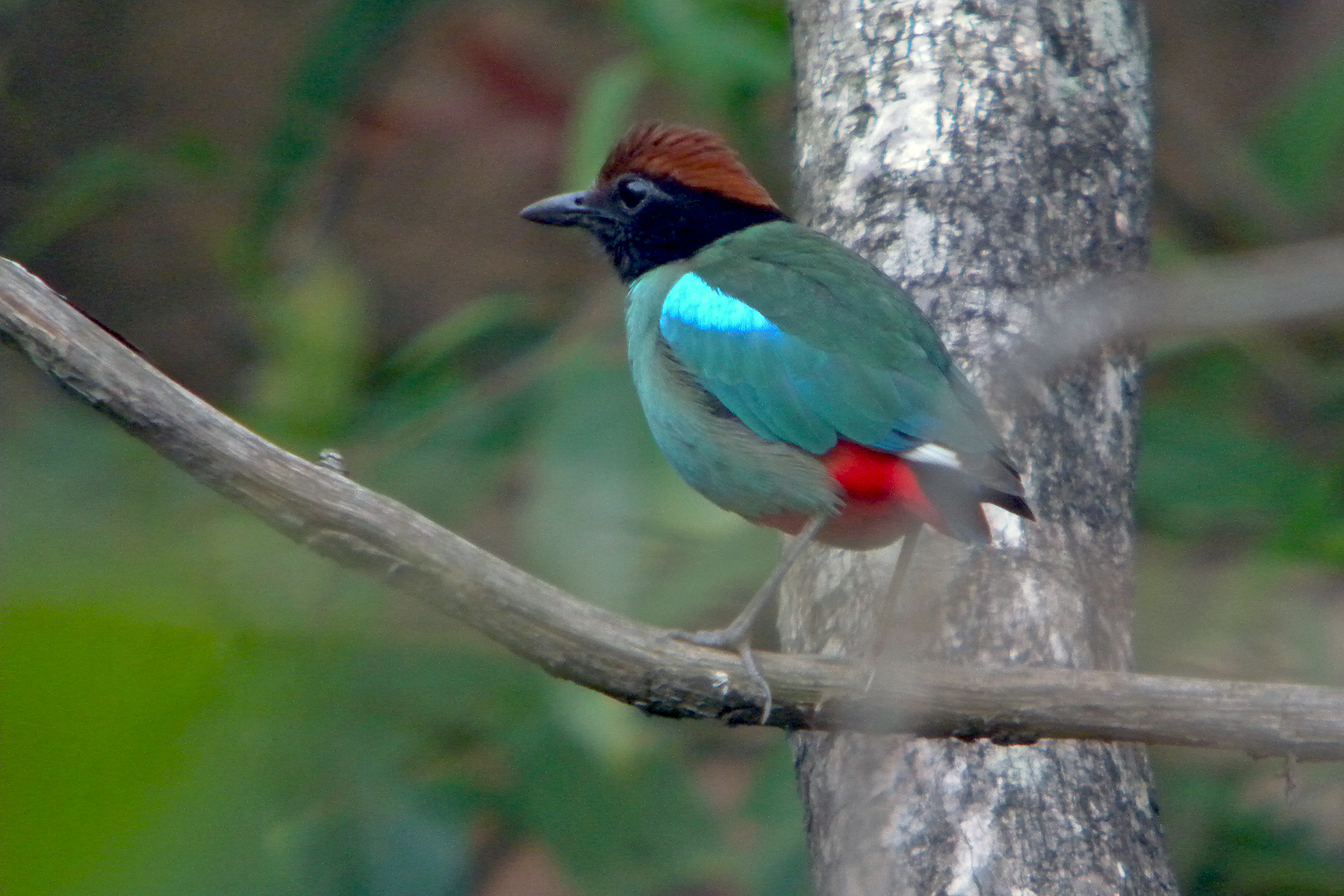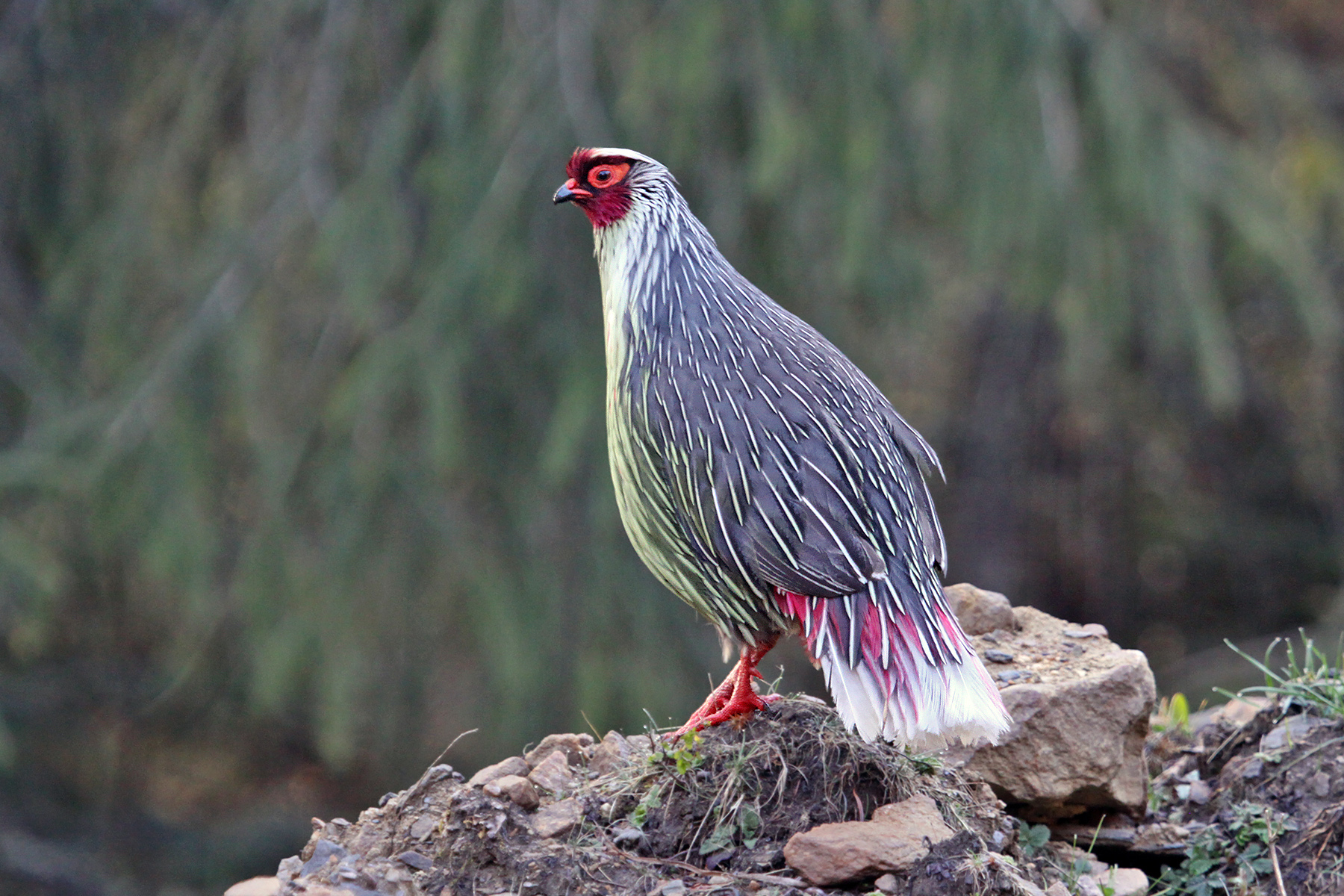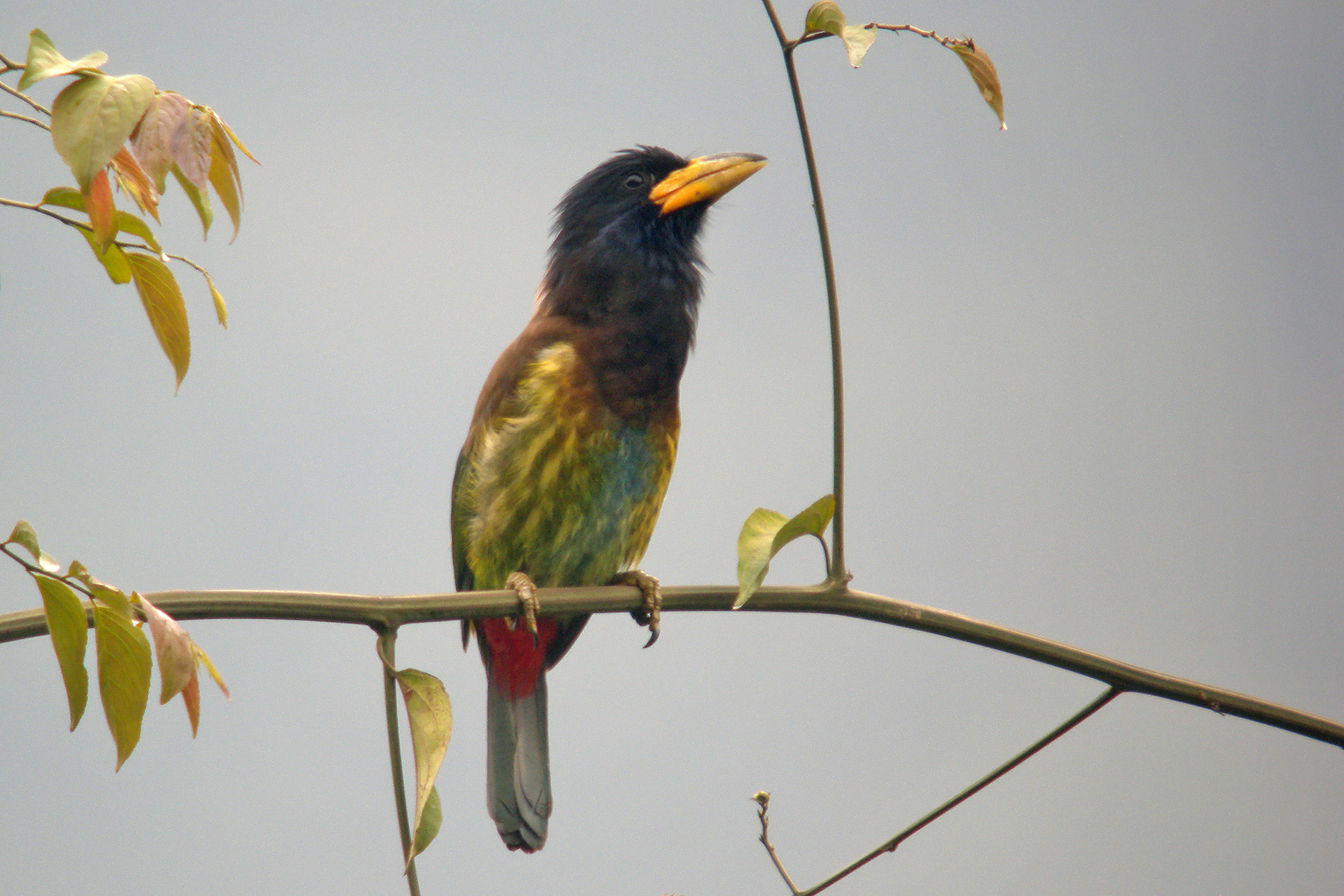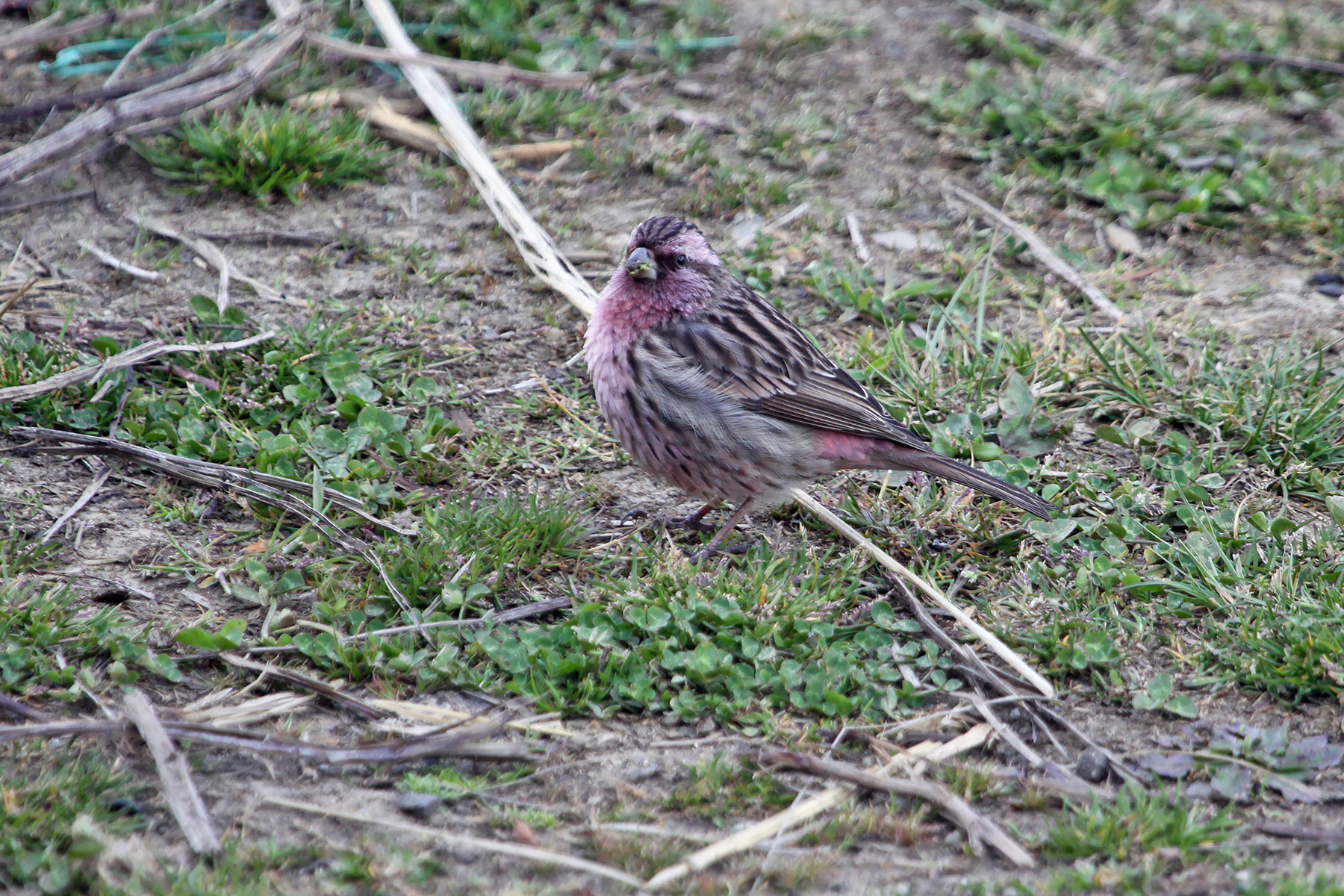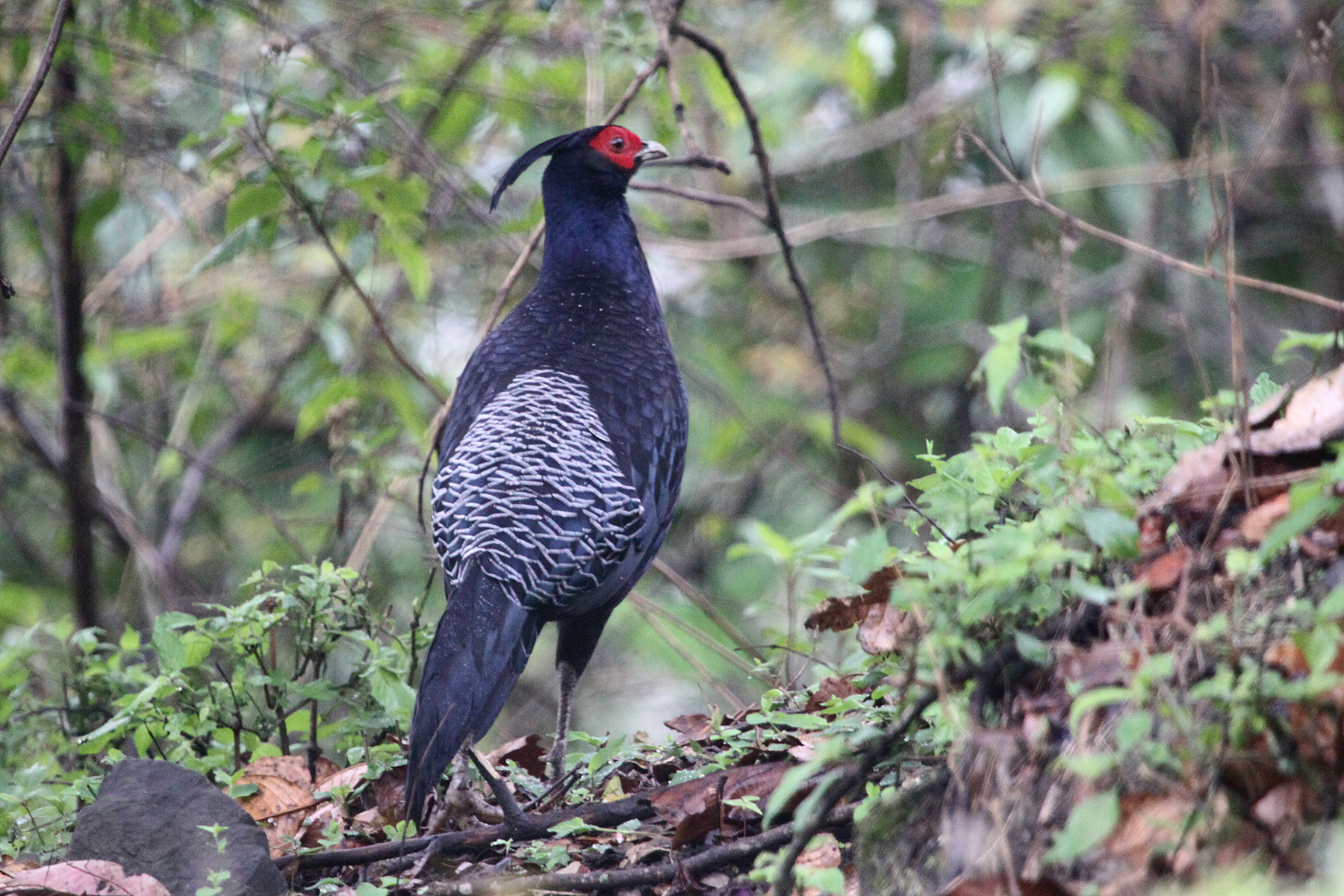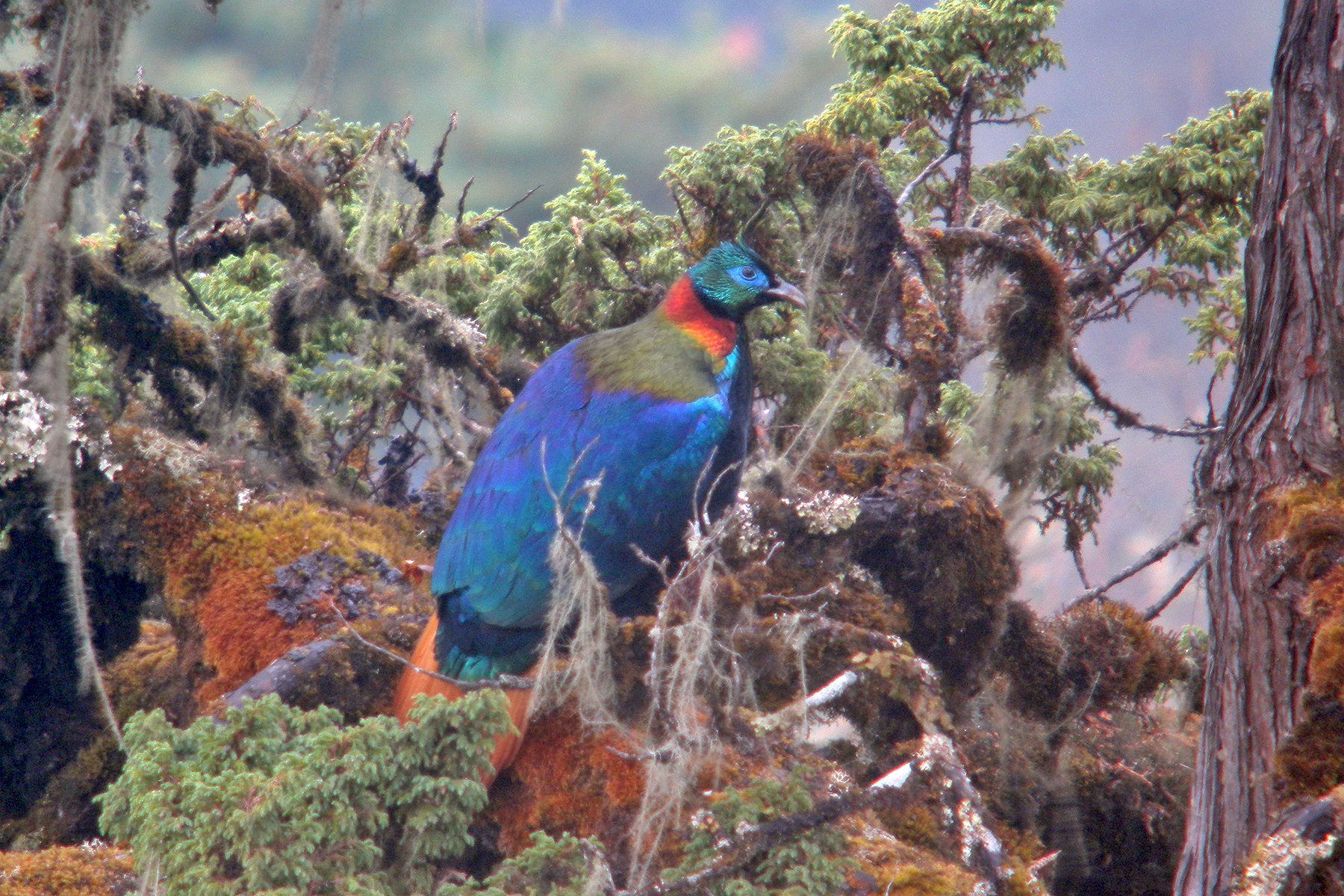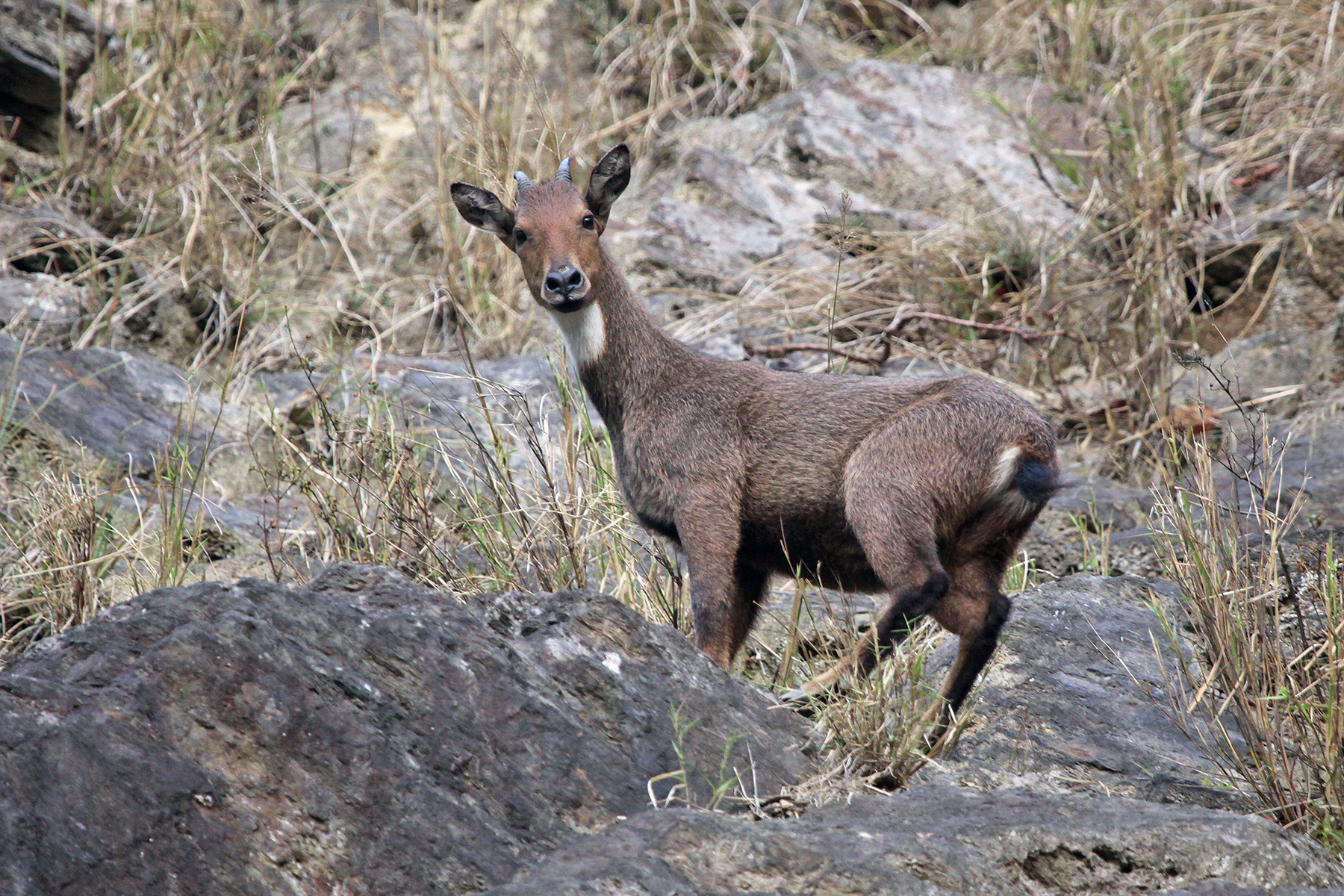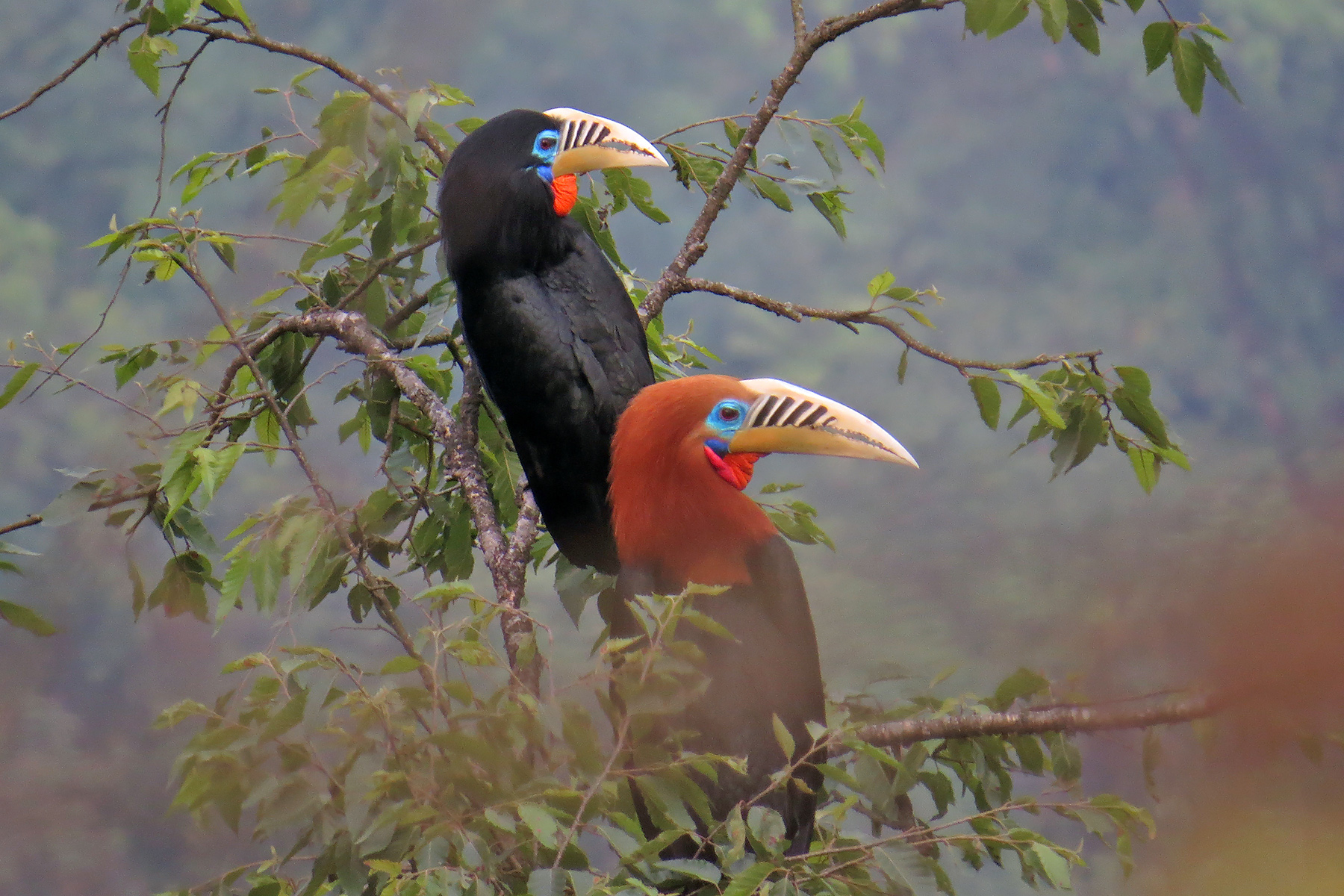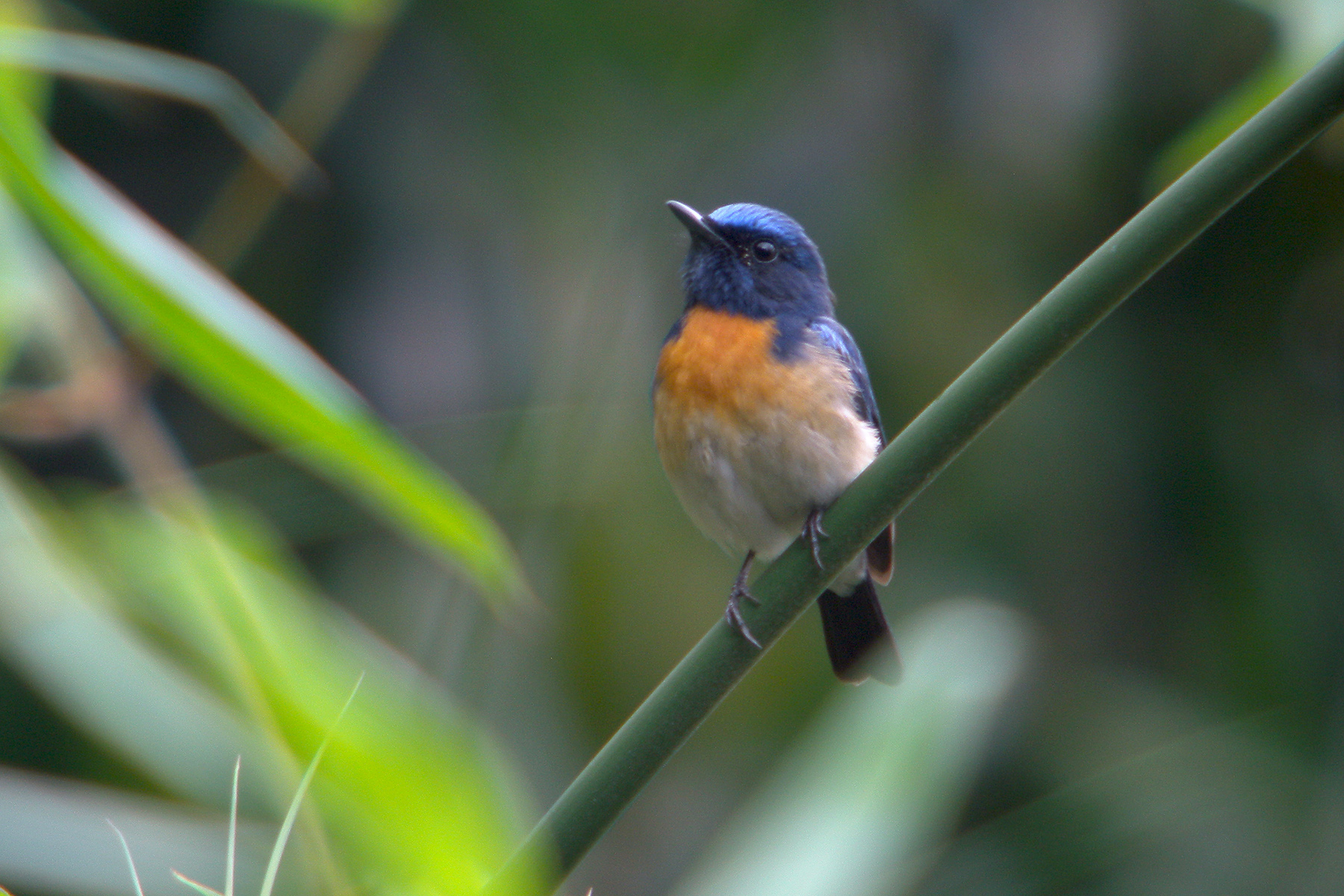BHUTAN BIRDING TOUR: DETAILED ITINERARY
Bhutan: Day 1 Our Bhutan birding tour starts this morning at Paro airport in western Bhutan.
(If you are arranging your international flights to and from the tour and would find it more convenient, we will be pleased to arrange your flights into and out of Paro on request. There are regular flights from and to Delhi and Bangkok.)
From Paro, we will travel eastwards passing Bhutan’s capital, Thimphu (which sits in a broad valley at an altitude of 2350m or 7710ft) and then crossing the Dochu La pass before reaching Punakha for a two nights stay. We will be staying at a traditionally decorated hotel perched high above the Puna Sang Chu valley.
Before we leave the Paro area we will have a first chance to explore the Paro valley, dominated by the impressive Paro Dzong. In particular, we shall be looking out for the strange and beautiful Ibisbill, which comprises a monotypic bird family, that can be found here amongst the gravel islands in the fast-flowing rivers, and also the furtive Black-tailed Crake. In addition, we have regularly found the sought-after Solitary Snipe in this part of Bhutan or elsewhere on our itinerary.
Typical breeding birds of the area include River Lapwing, Speckled Wood Pigeon, Oriental Turtle Dove, Eurasian Hoopoe, Common Kestrel, Grey-backed Shrike, Red-billed Chough, Large-billed Crow, Black Bulbul, Brown Dipper, Plumbeous Water Redstart, White-capped Redstart, Blue Whistling Thrush, White Wagtail and Eurasian Tree and Russet Sparrows, while lingering winter visitors may include Green and Common Sandpipers and Hodgson’s Redstart.
Bhutan: Day 2 The small town of Punakha (situated at 1350m or 4429ft) was once the capital of this tiny nation that preserves its cultural and natural heritage so keenly and both the town and the twin rivers that flow past it are dominated by the Punakha Dzong, sited at the confluence of the channels.
From Punakha, we shall travel up the Mo Chu (or Tashitang) Valley to an excellent area of forest where our birding will be concentrated. Along the river and its tributary streams, we should find Crested Kingfisher and perhaps Great Cormorant. A real possibility along the Mo Chu River is a true ‘mega-speciality’ of Bhutan, the very rare and little-known White-bellied Heron. We have our first chance of this speciality here but access to the best stretch of the river is fairly limited. There is also a chance for the increasingly uncommon Pallas’s Fish Eagle and if we are really in luck we will come across the impressive Tawny Fish Owl.
We will see a wide selection of forest species today, but in particular, we will be looking out for the localized Yellow-vented Warbler, which is common in these mid-altitude forests, and the delightful Spotted Elachura (sole member of its family), which positively vibrates as it pours out its amazingly loud song from a low perch.
Other birds we may well encounter include the smart Kalij Pheasant, Rufous-bellied Hawk-Eagle, the magnificent Black Eagle, Spotted Dove, Great and Golden-throated Barbets, Greater and Lesser Yellownapes, Rufous Woodpecker, Black-winged Cuckooshrike, Scarlet Minivet, Long-tailed Shrike, Maroon Oriole, Ashy and Hair-crested Drongos, Grey Treepie, Green-backed Tit, Red-vented and Mountain Bulbuls, Grey-hooded Warbler, White-throated and Striated Laughingthrushes, Rufous-chinned Laughingthrush (a bird that is typically easier to hear than see), Rufous Sibia, Nepal Fulvetta, Common Myna, Oriental Magpie-Robin, Small Niltava and Black-throated Sunbird.
Along the river on the outskirts of town, we will have another chance to find the splendid Ibisbill, while Slender-billed Oriole favours the nearby pine forest.
Providing time permits, we will take a look at the impressive Punakha Dzong this afternoon.
Bhutan: Day 3 Today we will travel southwards and then eastwards to Gangtey Gompa (monastery) in the Phobjika vallkey whgere we will stay overnight. Along the way we will pass Wangdi (or Wangdue) Phodrang Dzong, which sits above the Mo Chu river, guarding the crossing point.
During the first part of thejourney, we shall keep a lookout for any roadside cliffs festooned with the nests of Giant Rock Bees. Here we shall hope to find the little-known Yellow-rumped Honeyguide as it sits quietly alongside the bees’ nests. Eventually, we travel through some lichen-festooned forest where we will surely make some more birding stops.
On our way to the Phobjika we will have some time for a first exploration of the Pele La, a high pass situated at 3420m (or 11,220ft).
Birds we could well see today include Mountain Hawk-Eagle, Eurasian Sparrowhawk, Himalayan Buzzard, Blyth’s Swift, Long-tailed Minivet, the striking Yellow-billed Blue Magpie, Spotted Nutcracker, the diminutive, Phylloscopus-like Yellow-browed Tit, Rufous-vented, Grey Crested and Coal Tits, Nepal House Martin, Hume’s and Grey-sided Bush Warblers, Buff-barred, Lemon-rumped, Ashy-throated, Large-billed Leaf, Blyth’s Leaf and Whistler’s Warblers, Black-faced Laughingthrush, Bar-throated and Red-tailed Minlas, White-browed Fulvetta, Brown Parrotbill (and with luck, even the scarce and furtive Fulvous Parrotbill), Rufous-vented Yuhina, White-collared Blackbird, Dark-sided and Rufous-gorgeted Flycatchers, Chestnut-bellied Rock Thrush, Grey Bush Chat, Green-tailed Sunbird, Rosy Pipit and White-winged Grosbeak. We also have our first chance for the magnificent Himalayan Monal and slim chances for Bearded Vulture (or Lammergeier) and Fire-capped Tit.
Bhutan: Day 4 We will be up early today to look for Himalayan Owl and if we are lucky we will encounter the rare, localized and much-wanted Wood Snipe, which sometimes displays here early in the morning.
Afterwards, we leave Gangtey Gompa behind and continue eastwards along what is known as the ‘Lateral Road’, the only highway that crosses Bhutan from west to east. Seemingly without a straight stretch anywhere in the country, it was only surfaced in the 1980s. Its hairpins traverse the steep south-facing valleys of the region, giving us spectacular views over the forested landscape.
During our journey we will first cross the Pele La before reaching the town of Trongsa (or Tongsa). From the Yutong La (in the Dzongkha language that is spoken in Bhutan, ‘la’ is the word for a high pass) situated to the east of Trongsa, we drop down into the series of dry, pine-forested valleys known as Bumthang until we reach Jakar where we stay overnight at a beautiful wooden guesthouse.
We shall have some time to explore the slopes of the Yutong La pass, which is situated at around 3460m (or around 11,350ft) and possibly spend some more time on the Pele La as well. As well as further chances for ‘alpine’ species at the passes, once we come to Bumthang we may well encounter Ruddy Shelduck, Oriental Skylark and Common (or Red) Crossbill.
Bhutan: Day 5 Today we will cross over the second-highest pass of our journey, the Thrumsing La. Although the pass is situated at 3700m (or 12,140ft) it is still shrouded in thick hemlock and rhododendron forest. A very high treeline (around 4000m or 13,000ft) is a feature of the Eastern Himalayas, a consequence of the monsoon weather systems that come up from the Bay of Bengal and bestow a large amount of rainfall on these mountains.
The pass is frequented by some high-altitude birds such as the beautiful Blood Pheasant, the strikingly-patterned Snow Pigeon, Rufous-fronted Bushtit, Goldcrest, Spotted Laughingthrush, Great Parrotbill (uncommon), Golden Bush Robin, Rufous-breasted and Alpine Accentors, Mrs Gould’s and Fire-tailed Sunbirds and Himalayan Beautiful Rosefinch. Migrant Tickell’s Leaf Warblers may also be encountered. We also have a good chance for the fantastic little Fire-tailed Myzornis, either here or at one of the other high passes along our route.
As we descend from the pass, we will see forested ridges stretching away as far as the eye can see. Immediately below us will be a forested mountainside, so steep that if it was not for the fact that a road winds its way down it, by means of numerous hairpin bends, it would be inaccessible to all but the hardiest and most agile of adventurers. This is the area that has been dubbed the ‘Lingmethang Road’ by the few lucky ornithologists to have reached this Shangri-la of Himalayan birding.
As there is no conventional accommodation in the area, we will stay for five nights in our comfortable mobile-safari-style camp erected by our local outfitters. The camp has walk-in tents, proper camp beds, flush toilets and even hot showers. We will spend two nights in the upper levels of the road and three nights much lower down.
Bhutan: Days 6-9 The ‘Lingmethang Road’ bisects every forest altitudinal zone between 3700m and the valley bottom at 650m, an incredible drop of 3050m in just 79 kilometres! Very few birdwatchers can say they have visited this remote area and yet it holds some of the most sought-after Himalayan species. The Eastern Himalayas are the most diverse part of that mighty mountain range, and their steep profile means that from the plains to the highest peaks the distance can be as little as 80 kilometres in places! The list of birds here is large and diverse, and our tally will include many species characteristic of the Eastern Himalayas. We shall, however, be concentrating on a number of prime specialities.
The calls of Ward’s Trogon, a montane species entirely restricted to the Eastern Himalayas, are soft but quite far-carrying and we are likely to hear this wonderful bird before a vision of pink heralds the arrival of a male in a nearby forest giant. Rufous-necked Hornbills still survive here and can sometimes be seen slowly flapping their way along the ridges, or perched in the top of a tall tree.
Another star attraction is the stunning but secretive Satyr Tragopan, which is not uncommon here. We will listen for their rather braying calls, and persistence will likely be rewarded by views of a glowing red male, covered in white spots, stalking across a bamboo-choked hillside, with the drab female quietly feeding nearby. Sometimes they seem quite unconcerned by human beings, even emerging onto the roadside verges.
The skulking Blue-fronted Robin is easily heard but hard to get good views of as it flits from one perch to another amongst the undergrowth. Rather easier are the noisy bands of Yellow-throated Fulvettas and Grey-cheeked Warblers that are a conspicuous part of the avifauna in the lower levels. The large Pale-billed Parrotbill tends to go around in noisy groups, often keeping company with Rusty-fronted Barwings, while other bird waves often contain smart White-naped Yuhinas.
As always, wren-babblers are a delight to watch and we will enjoy seeing Rufous-throated Wren-Babblers bobbing up and down and, if we are fortunate, Long-billed and Bar-winged Wren-Babblers and the strange Sikkim Wedge-billed Babbler (the latter singing away in a roadside ravine). Coral-billed Scimitar Babblers like to hack away at wild bananas in search of insects, but the amazing Slender-billed Scimitar-Babbler clambers up and down creeper-infested tree trunks and tall bamboos, probing into the deepest crevices with its extraordinarily long and finely curved bill. Deep in the bamboos, Broad-billed Warblers call thinly, only occasionally venturing out onto the edge of the clump.
Other likely species include Crested Goshawk, Large Hawk-Cuckoo, Common, Himalayan and Lesser Cuckoos, the dazzling Asian Emerald Cuckoo, Himalayan Swiftlet, White-throated Needletail, Grey-headed, Crimson-breasted and Bay Woodpeckers, Grey-chinned Minivet, Blyth’s and Black-eared Shrike-babblers, Lesser Racket-tailed Drongo, Yellow-bellied Fantail, Grey-headed Canary-flycatcher, Yellow-cheeked Tit, Striated Bulbul, Scaly-breasted and Pygmy Cupwings, the minuscule Chestnut-headed, Slaty-bellied and Grey-bellied Tesias, Mountain Tailorbird, Brown-flanked Bush Warbler, Black-throated Prinia, Green-crowned, Chestnut-crowned and Black-faced Warblers, Streak-breasted and Rusty-cheeked Scimitar Babblers, White-crested, Grey-sided, Scaly and Chestnut-crowned Laughingthrushes, the near-endemic Bhutan Laughingthrush, Red-billed Leiothrix, Himalayan Cutia, Blue-winged Minla, Hoary-throated Barwing, Whiskered, Stripe-throated and Black-chinned Yuhinas, Rufous-winged Fulvetta, the stunning little Golden-breasted Fulvetta, Black-throated Parrotbill, Verditer, Little Pied, Ultramarine and Pale Blue Flycatchers, the shy Sapphire Flycatcher, the secretive White-gorgeted Flycatcher, Large and Rufous-bellied Niltavas, White-browed and Lesser Shortwings, White-tailed Robin, Grey-winged Blackbird, Blue-capped Rock Thrush, White-tailed Nuthatch, Sikkim Treecreeper, Fire-breasted Flowerpecker, Olive-backed Pipit, Yellow-breasted Greenfinch and Dark-rumped Rosefinch.
If we are lucky we will find Black-headed Shrike-babbler, Crimson-browed Finch or the dapper Golden-naped Finch.
Hill, Rufous-throated and Chestnut-breasted Partridges can be heard calling from the hillsides, and with persistence, we should see at least one of these wary species either here or elsewhere during our travels.
We have even been fortunate enough to come across the sought-after Gould’s Shortwing in this fabulous area, pausing on its way to its breeding grounds above the treeline!
Bhutan: Day 10 After some last birding along the wonderful Lingmethang Road we will return to Jakar in the Bumthang district for an overnight stay at the same comfortable guesthouse.
Bhutan: Day 11 Today we will recross the Yutong La, providing us with more chances for high-altitude birds, and then, on reaching Trongsa, turn southwards towards Tingtibi. We will be spending a total of four nights camping in the Tingtibi area itself and between Tingtibi and Gelephu
The journey to Tingtibi provides us with another chance for the scarce Yellow-rumped Honeyguide.
Bhutan: Days 12-14 Some magnificent subtropical forests can still be found by the roadsides in the Tingtibi region, which still remains an ornithologically little-known region of Bhutan, and these offer some of the best birding in the entire country.
One of the star attractions of this fine area is Beautiful Nuthatch, which survives here at one of its few known localities. We have a very good chance of encountering this mega-star amongst the taller trees, probably being first alerted by its remarkably loud calls.
Many other great birds occur in this bird-rich area, including the superb Rufous-necked and Blue-winged Laughingthrushes and the lovely Red-faced Liocichla. We should also encounter the magnificent Rufous-necked Hornbill and the beautiful Golden Langur monkey.
We also have chances for four of the more difficult specialities: Chestnut-breasted and Rufous-throated Partridges (both likely to be heard but hard to see), the localized and restricted-range Collared Treepie and Green Cochoa.
At a forested mountain pass, where the forest is rich with moss and orchids and the bamboo forms a dense undergrowth below the evergreen broadleaf forest, the restricted-range Scarlet Finch and Brown Bullfinch can both be found.
Other species of particular interest we are likely to see include Pin-tailed Green Pigeon, the secretive but noisy Hodgson’s Hawk-Cuckoo, White-browed Piculet, Fulvous-breasted Woodpecker and White-throated Bulbul.
Amongst the many other birds that we may well encounter are Crested (or Oriental) Honey Buzzard, Crested Serpent Eagle, Shikra, Common Emerald Dove, Bar-tailed Cuckoo-Dove, Wedge-tailed Green Pigeon, Mountain Imperial Pigeon, Indian and Plaintive Cuckoos, Square-tailed Drongo-Cuckoo, Green-billed Malkoha, Asian Barred Owlet, Blue-bearded Bee-eater, Blue-throated Barbet, Grey-capped Pygmy Woodpecker, the handsome Long-tailed Broadbill, Bronzed Drongo, Common Green Magpie, the impressive Sultan Tit, Ashy Bulbul, Rufous-faced and Yellow-bellied Warblers, Black-throated Bushtit, Striated Prinia, Grey-throated and Golden Babblers, White-browed Scimitar Babbler, Lesser Necklaced Laughingthrush, Long-tailed Sibia, Silver-eared Mesia, Striated Yuhina, Pygmy and Blue-throated Blue Flycatchers, Spotted and Slaty-backed Forktails, Oriental White-eye, Chestnut-bellied Nuthatch, Orange-bellied Leafbird, Crimson Sunbird, Streaked Spiderhunter and Crested Bunting.
We are quite likely to hear the secretive Grey Peacock-Pheasant, but seeing one is another matter as they are exceptionally wary.
Bhutan: Day 15 Today we will descend through the Himalayan foothills to the town of Gelephu (or Gelephug), situated close to the border with India. The Bhutanese side of the border is still partly forested, so we shall be able to briefly experience a mixture of ‘Assam’ plains and lower foothill forest birding today. Indeed, this will be the only area on our Bhutan itinerary where we are at such low altitudes.
All the species that occur around Gelephu are widespread in the region and the most likely new birds to be encountered include Rose-ringed and Red-breasted Parakeets, Asian Palm Swift, House Swift, Indochinese Roller, White-throated Kingfisher, Great Hornbill, Lineated Barbet, House Crow, Cinereous Tit, Black-crested Bulbul, Common Tailorbird, Indian Pied, Great and Jungle Mynas, and Golden-fronted Leafbird.
Less likely (simply because of our very short time in the area) are Little Egret, Red-wattled Lapwing, Thick-billed Green Pigeon, Green Imperial Pigeon, Asian Koel, Red-headed Trogon, Wreathed and Oriental Pied Hornbills, Coppersmith and Blue-eared Barbets, Alexandrine Parakeet, Speckled Piculet, Large Woodshrike, Ashy Woodswallow, Large Cuckooshrike, Black-hooded Oriole, Greater Racket-tailed and Black Drongos, Asian Fairy-bluebird, Common Hill Myna and Paddyfield Pipit.
From Gelephu, we will head back into the hills as we travel westwards to the remote settlement of Tsirang for our final night of camping.
Bhutan: Day 16 Our prime reason for coming to Tsirang is to explore some untamed stretches of rivers where the rare and probably critically endangered White-bellied Heron still occurs in small numbers. Bhutan is most definitely the best place for this rarity, and pairs nest in the Tsirang area, but even so as the area is large and access to the rivers patchy, we will need a bit of good fortune to locate our quarry.
There are many other Himalayan foothill species to be found in the Tsirang area and we are likely to get a few useful ‘catch ups’.
After spending much of the day in the Tsirang area, we will head northwards to Wandue Phodrang for an overnight stay. This small town is situated on Bhutan’s Lateral Highway not far from Punakha and is convenient for our visit to the Dochu La tomorrow.
Bhutan: Day 17 This morning we will climb up to the high forests of the Dochu La. Where the road climbs to around 3100m (or around 10,170ft), rising above the dry, pine-dominated forests of western Bhutan, we enter stands of hemlock, fir, rhododendron and evergreen oak which we will want to explore. We will stop at the pass where, on a clear day, there is a spectacular, panoramic vista of the snowy massifs of the high Himalayas to the north.
Birding here will include some of the best ornithological delights of the Eastern Himalayas. In particular, this is a good locality for the lovely but restless Fire-tailed Myzornis (although we will also have chances for this unpredictable star bird further east, for example at Thrumsing La).
We will have seen most of the likely species at Dochu La while birding at other passes during our journey through Bhutan, but Dochu La is particularly reliable for Darjeeling and Rufous-bellied Woodpeckers, Rusty-flanked Treecreeper and Red-headed Bullfinch. Dark-breasted Rosefinch may also be encountered.
After birding at the Dochu La, we will continue to Paro for a two nights stay.
Bhutan: Day 18 We will set off early today to drive up to the spectacular Chele La pass on the road to Haa, which at a breath-taking 3780m (or around 12,400ft) is the highest point we reach during our journey. We will hope for good weather as the Himalayan views are wonderful.
Chele La is an excellent spot for seeing the spectacular Himalayan Monal. This has to be one of the most colourful and strikingly patterned of all the world’s many pheasants, so that is saying a lot! Seeing an adult male at relatively close range as it shows off its iridescent blue, indigo, orange, green and black plumage is an extraordinary experience, and when one flies off displaying its white back patch and uttering its wild, ringing cry the moment seems to epitomize High Himalayan birding in all its glory!
During our visit to Chele La, we will also have another opportunity to find the attractive Blood Pheasant as well as a good selection of other high mountain birds.
A suite of great birds regularly found here includes Greenish Warbler, Indian Blue Robin, White-browed Bush Robin, Himalayan Bluetail, Blue-fronted Redstart, the uncommon Alpine Thrush, the huge Collared Grosbeak and Himalayan White-browed Rosefinch. We should also see Grey Nightjar as we ascend the pass.
Bhutan: Day 19 Our Bhutan birding tour ends this morning at Paro airport.












